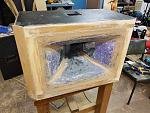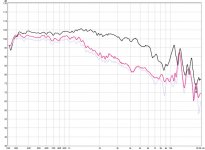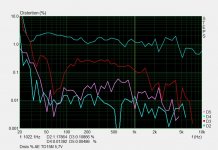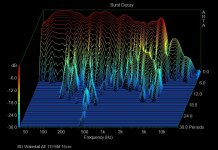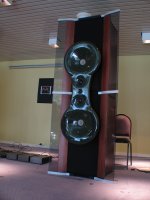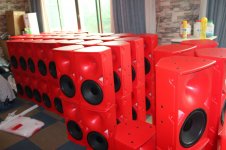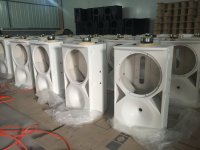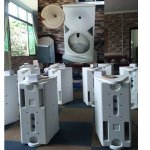It is, but since this is an array-able system with FIR-phase, I guess there are ways to compensate/correct the flip.
Reckon I can cross this around 800hz?
I wanted to cross low, I got the "long throw" version of that horn (30cm long) from the same vendor, and mounted it in a gutted PA cabinet. I used lots of filler to blend the horn edge into the cabinet, as shown.
This is the response (with mic right at horn mouth).
Black line = old 16ohm compression driver.
Coloured lines = new 4" cone drivers
Attachments
to me the Fs is very important because as far as I'm aware Fs defines the lower natural roll off possible when one is looking "to cover the whole spectrum".
Lots of systems use EQ / DSP. The natural roll off doesn't matter to them.
Simplistically, when I look at a set of T&S specs I look to:
- Fs (how low can it play)
- Vas (how big an enclosure does it want)
- Qts (what alignment will it prefer).
So my original question remains, where to find a diver like the TAD?
If $ matters, you need to buy local. Shipping and customs is pretty bad with big items.
DJ City used to stock Faital drivers, but they seem to be almost sold out.
Maybe Etone? Based on the published specs, the NEO-1501 is exactly what you want.
etone PROFESSIONAL SOUND
...but I've never bought from them / cannot personally endorse them.
Maybe I'm missing something - help me please! - but to me the Fs is very important because as far as I'm aware Fs defines the lower natural roll off possible when one is looking "to cover the whole spectrum".
Simplistically, when I look at a set of T&S specs I look to:
- Fs (how low can it play)
- Qts (what alignment will it prefer).
How low a driver can play is limited to excursion...not Fs
Your other listings are likely logical...though the reason I chose low qts drivers wasn't to aim for a certain alingment...I modelled and could have built a sealed, Br, or TL, or Sealed TL...at any whim...I still am not sure if I'm supposed to build a vented design tuned to 15hz lol...I chose low qts because sonically the driver behaves better than a higher qts driver, in my eyes....but as I've been corrected before...Q of the driver+box dominates, no less than Fs vs Fc or Fv... While non of those will limit a driver from producing a particular frequency.
Acoustic elegance isn't in that list of "Everything"
Comparison of some respected 15" woofers:
- TD15M 8 Ohms, VB = 180.0 L, FB = 35.0 Hz
- Faital Pro 15PR400 VB = 180.0 L, FB = 35.0 Hz
- TAD TL-1601A, VB = 180.0 L, FB = 30.0 Hz
- TAD TL-1601B, VB = 180.0 L, FB = 30.0 Hz
- TAD TL-1601C, VB = 180.0 L, FB = 35.0 Hz
- TAD TL-1603, VB = 180.0 L, FB = 30.0 Hz
Both the TD15M and 15PR400 are on average 2dB more sensitive than the TADs, but the TADs are (by a very small margin) kings of low frequency extension.
Personally, I wouldn't bother about the latter in my room.
Attachments
-
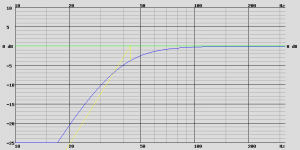 AESPEAKERS TD15M 8 Ohms, V B = 180.0 L, F B = 35.0 Hz, 0 dB corresponds to 97.3 dB.png3.9 KB · Views: 293
AESPEAKERS TD15M 8 Ohms, V B = 180.0 L, F B = 35.0 Hz, 0 dB corresponds to 97.3 dB.png3.9 KB · Views: 293 -
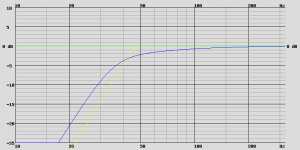 FAITAL PRO 15PR400, VB = 180.0 L, FB = 35.0 Hz, le 0 dB correspond à 97.4 dB.png3.9 KB · Views: 310
FAITAL PRO 15PR400, VB = 180.0 L, FB = 35.0 Hz, le 0 dB correspond à 97.4 dB.png3.9 KB · Views: 310 -
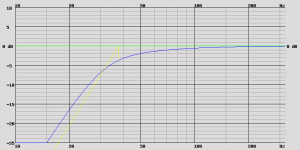 TAD TL-1601 A, V B = 180.0 L, F B = 30.0 Hz, the 0 dB corresponds to 95.2 dB.png4 KB · Views: 297
TAD TL-1601 A, V B = 180.0 L, F B = 30.0 Hz, the 0 dB corresponds to 95.2 dB.png4 KB · Views: 297 -
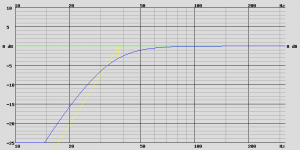 TAD TL-1601 B, V B = 180.0 L, F B = 30.0 Hz, the 0 dB corresponds to 94.8 dB.png4 KB · Views: 297
TAD TL-1601 B, V B = 180.0 L, F B = 30.0 Hz, the 0 dB corresponds to 94.8 dB.png4 KB · Views: 297 -
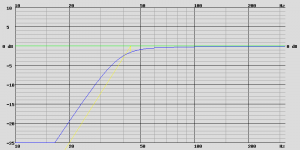 TAD TL-1601 C, V B = 180.0 L, F B = 35.0 Hz, the 0 dB corresponds to 95.2 dB.png3.9 KB · Views: 193
TAD TL-1601 C, V B = 180.0 L, F B = 35.0 Hz, the 0 dB corresponds to 95.2 dB.png3.9 KB · Views: 193 -
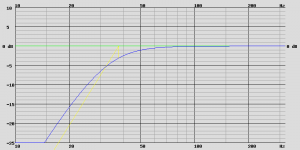 TAD TL-1603, VB = 180.0 L, FB = 30.0 Hz, the 0 dB corresponds to 94.7 dB.png3.9 KB · Views: 158
TAD TL-1603, VB = 180.0 L, FB = 30.0 Hz, the 0 dB corresponds to 94.7 dB.png3.9 KB · Views: 158
Last edited:
Both the TD15M and 15PR400 are on average 2dB more sensitive than the TADs, but the TADs are the kings of low frequency extension.
Is this a audible in home environment?
Illustration of relativity of low freq. extension versus efficiency. Taking 2 to 3 dB baffle step around 200Hz into account, what's left is 98 dB sensitivity at 50 Hz (red is port output).
The difference is not just a matter of amplifier current.
The difference is not just a matter of amplifier current.
Attachments
Last edited:
Is this a audible in home environment?
You know the answer to your own question Barossi, based on your experience (with the 15PR400) 😉
Regarding measurement data of woofers, there are only 2 truly relevant plots imo: IMD and burst decay. The sonogram is useful as a backup.
Unfortunately, these plots are rarely published.
Some plots of the TD15M (harmonics at 5.7v (about 103db / 1m)).
Unfortunately, these plots are rarely published.
Some plots of the TD15M (harmonics at 5.7v (about 103db / 1m)).
Attachments
Your last comment (which I agree with) doesn't support your reply to me unless youve already seen or know the outcome of the CSD and IMD of mentioned drivers...
What connection does fs have to these measurements... one, performance at tuning is worst...but system tuning dominates so why even consider fs outside of speculation of box design.
On second thought, I could say that it would result in less eqing
Referring back to discussion with Dr. Geddes...xmax and power handling are about as deep as it goes...(pun?)
A unique question for you advance engineers....source(location) of Q....it must be a factor...in my mind simulator, low compliance at the suspension coupled with motor force in the middle of the cone, isn't optimal, and a proper design would put suspension resistance in the same location as the motor attachment..... and I guess there, is the epiphany, i.e. the way a compression driver diaphragm, suspension and motor, is built...or something in its likeness.
Ps...is a period a ms in this case?
What connection does fs have to these measurements... one, performance at tuning is worst...but system tuning dominates so why even consider fs outside of speculation of box design.
On second thought, I could say that it would result in less eqing
Referring back to discussion with Dr. Geddes...xmax and power handling are about as deep as it goes...(pun?)
A unique question for you advance engineers....source(location) of Q....it must be a factor...in my mind simulator, low compliance at the suspension coupled with motor force in the middle of the cone, isn't optimal, and a proper design would put suspension resistance in the same location as the motor attachment..... and I guess there, is the epiphany, i.e. the way a compression driver diaphragm, suspension and motor, is built...or something in its likeness.
Ps...is a period a ms in this case?
Last edited:
You can read about the difference between periods vs ms and BD vs waterfall in the Arta manual (paragraph 6.5.4, page 120).
Maybe I'm missing something - help me please! - but to me the Fs is very important because as far as I'm aware Fs defines the lower natural roll off possible when one is looking "to cover the whole spectrum".
Simplistically, when I look at a set of T&S specs I look to:
- Fs (how low can it play)
- Vas (how big an enclosure does it want)
- Qts (what alignment will it prefer).
So my original question remains, where to find a diver like the TAD?
Not that I'm aware of since the lower the Fs, the wider its [potential] BW.
Ditto except add Xmax, inductance [Le].
Not cheap, but this remake of an '80s Altec studio monitor woofer appears to be a contender: http://greatplainsaudio.com/wp-content/uploads/2016/06/3154.pdf
low compliance at the suspension coupled with motor force in the middle of the cone, isn't optimal
Not sure I follow, but the pioneers got it right in that it's like a solenoid, so center driven with the spider its compliance, the surround was for centering, sealing.
Your last comment (which I agree with) doesn't support your reply to me unless youve already seen or know the outcome of the CSD and IMD of mentioned drivers...
What connection does fs have to these measurements... one, performance at tuning is worst...but system tuning dominates so why even consider fs outside of speculation of box design.
On second thought, I could say that it would result in less eqing
Referring back to discussion with Dr. Geddes...xmax and power handling are about as deep as it goes...(pun?)
A unique question for you advance engineers....source(location) of Q....it must be a factor...in my mind simulator, low compliance at the suspension coupled with motor force in the middle of the cone, isn't optimal, and a proper design would put suspension resistance in the same location as the motor attachment..... and I guess there, is the epiphany, i.e. the way a compression driver diaphragm, suspension and motor, is built...or something in its likeness.
Ps...is a period a ms in this case?
There is no unequivocal or simple answer to your cited aspects, I'm afraid.
We also have to distinguish between limited passband and wideband applications.
Woofers, more specifically traditional cone woofers, are perfectly capable of working in pistonic motion. It's the frequency range in which a woofer stays (more or less) pistonic that matters.
Earlier I referred to the Japanese engineer who compared different high-end woofers (including the Sony SUP-L11, TAD 1601 and Altec 416B).
When pressing the cones, only the Altec cone moved in its entirety without deformation.
Apart from the numerous sources of interference that are inherently related to the motor and suspension parts, "the cone break-up behaviour and frequency response is strongly dependant on the Geometrical Stiffness of the Cone, which should therefore be considered a very important design parameter".
Not sure I follow, but the pioneers got it right in that it's like a solenoid, so center driven with the spider its compliance, the surround was for centering, sealing.
I am suggesting that the way a compression drivers diaphragm is made is better than how a dynamic driver is made....It seems that way to me that is...So since the motor force is being applied at the same place suspension resistance resides... things are more balanced....with a dynamic driver pushing in the center and resistance from the suspension on the outer OD...just seems like a recipe for more flexing. Just an opinion.
The compression driver is like a more solenoid like than a dynamic driver...in my eyes.
Rereading you response Gm, I see that you are not disagreeing with my comments about where resistance should live in respect to motor force...and describing what I tried to describe in different words....as the spider in a CD may be its compliance as far as I know.
Can't fight with facts lol...In my mind I was thinking of Bass mainly. For example large woofers....I agree with your points regarding geometry....it just seems having placing resistance on the OD and motor force on the "ID" would not be better than how a compression diaphragm does it.Woofers, more specifically traditional cone woofers, are perfectly capable of working in pistonic motion.
Last edited:
I failed to see the connection to FS and Bandwidth, please school meNot that I'm aware of since the lower the Fs, the wider its [potential] BW.
Driver a vs driver b all things identical but fs...
A fs is 45, B fs is 25
Put them in a ported box tuned to 30 and FR matched with eq....whats the sonic difference outside of group delay???
This is an informative thread about woofers in general, in light of development of this beast:
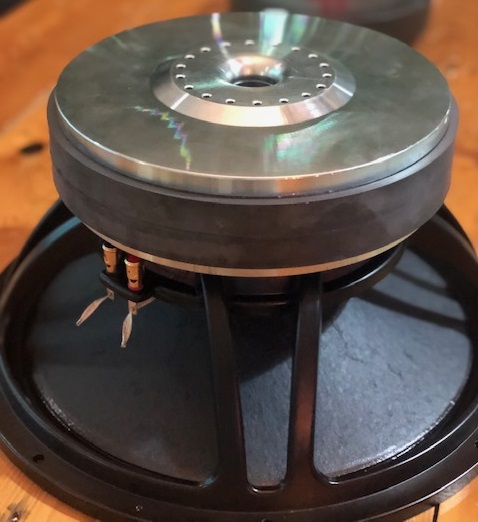
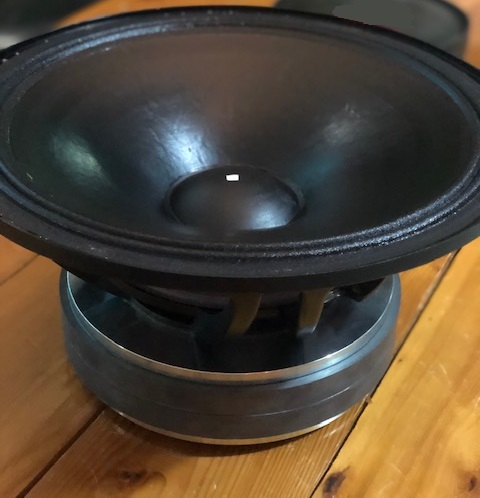
The dustcap is rather small for a reason.
Member Snicker-is is one of the most knowledgeable about loudspeaker (driver) engineering I know.
Years ago, he designed this (including the amps):
The dustcap is rather small for a reason.
Member Snicker-is is one of the most knowledgeable about loudspeaker (driver) engineering I know.
Years ago, he designed this (including the amps):
Attachments
Last edited:
2 way with (OS?) waveguide from China:
Attachments
I am suggesting that the way a compression drivers diaphragm is made is better than how a dynamic driver is made....Just an opinion.
The compression driver is like a more solenoid like than a dynamic driver...in my eyes.
Rereading you response Gm, I see that you are not disagreeing with my comments
OK, wasn't sure.
Not the big solenoids I worked with........
No, not really, but we need to look at it as it relates to point source drivers in that the VC sets the driver's upper pistonic limit, so with the VC out at its perimeter, at best it's only going to be pistonic from that frequency up to the diaphragm's breakup modes, i.e. a 15" woofer will be a very large mids up driver unless mounted on a very large baffle to support its lower BW down to Fs, so what is a horn but a folded up baffle that sets the driver's LF BW........... 😉
So once again the pioneers worked it out for us, just there never was much need for huge bass horns, much less sub bass horns, so the 'bean'counters' won out, limiting the most correct way to design drivers to the ~500 Hz XO point where the acoustic power BW of music is ~ equally divided.
I failed to see the connection to FS and Bandwidth, please school me
Driver a vs driver b all things identical but fs...
A fs is 45, B fs is 25
Put them in a ported box tuned to 30 and FR matched with eq....whats the sonic difference outside of group delay???
Again, the lower the Fs, the wider its harmonic BW, ergo Dc = infinite BW.
For this reason the lower the system's Fs, the 'fuller', more 'extended' we perceive the whole BW whether or not the HF is equally balanced [extended] and apparently why the pioneers designed speakers tuned somewhat below the lowest notes on the recordings.
Conversely, if the HF signal is prominent up to 20+ kHz our brain will reconstruct a rolled off low end and one reason why some folks claim we ideally need up to 40 kHz systems.
- Home
- Loudspeakers
- Multi-Way
- Is it possible to cover the whole spectrum, high SPL, low distortion with a 2-way?
